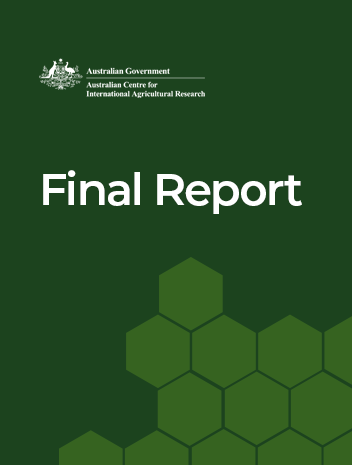- HomeHome
-
About ACIAR
- Our work
- Our people
-
Corporate information
- ACIAR Audit Committee
- Commission for International Agricultural Research
- Policy Advisory Council
- Agency reviews
- Executive remuneration disclosure
- Freedom of information (FOI)
- Gifts and benefits register
- Information publication scheme
- List of new agency files
- Contracts
- Legal services expenditure
- Privacy impact assessment register
- Commonwealth Child Safe Framework
- Benefits to Australia
- Careers
- 40 years of ACIAR
-
What we do
- Programs
- Cross-cutting areas
- Resources
- Where we work
-
Funding
- Research projects
- Fellowships
-
Scholarships
- John Allwright FellowshipScholarships to study in Australia for ACIAR partner country scientists to have Australian postgraduate qualifications
- ACIAR Pacific Agriculture Scholarships and Support and Climate Resilience Program
- Alumni Research Support Facility
- Publications
- News and Outreach
Project final report
Management of Acacia decurrens Pests and Diseases in Ethiopia - Final Report
Date released
16 January 2023
ISBN
978-1-922787-60-6
Publication Code
FR2022-035
Overview
This project aimed to determine the key pests and pathogens of A. decurrens; identify and monitor pest distribution; and test the efficacy of integrated pest management (IPM) options in small-scale nursery and plantation trials.
A total of 370 wattle trees were assessed across the Awi Zone. Most (70.2%) were in Fageta Lekoma and Ankesha Gagusa districts, where 12 of the 17 sites were assessed. The remaining 29.8 % of the trees were in Banja and Dangila district.
Wattle is widely planted in Awi Zone, Ethiopia, for soil reclamation and improvement, land rehabilitation, afforestation, reforestation, construction, charcoal, firewood, and animal fodder. Recently, several insect pests and diseases were reported threatening wattle production in the nursery and the field. To address these threats, surveys of Acacia plantations were conducted in four districts of the Awi Zone to determine the key pests, their distribution, and to quantify their prevalence and severity.
The results indicated that the main disease was the wattle rust pathogen, Uromycladium acaciae (Pucciniales: Pileolariaceae), with severe epidemics present at all surveyed plantations. In addition, three insect pests were identified at low levels of infestation and severity, including cottony cushion scale, Icerya purchasi (Hemiptera: Monophlebidae), a treehopper (Hemiptera: Membracidae), and a bagworm (Lepidoptera: Psychidae). The soil-borne pathogens Phytophthora spp. and Calonectria pauciramosa and the stem canker pathogen Diaporthe australafricana were also detected.
In Ethiopia, wattle production sustains many jobs in rural communities such as nursery production, silvicultural activities in plantations, charcoaling, and the associated roles of transportation, handling, wholesaling, and retail selling. However, the production of seedlings and cultivation of year-one and year-two seedlings has become almost impossible due to the rust pathogen. Production in the Awi Zone is, therefore, threatened and causing concern among growers, foresters, developmental agents, rural communities, and all actors along the value chain. Considering the current threat, the socioeconomic impact in the coming years is likely to increase.
The wattle species in Ethiopia was previously thought to be green wattle, A. decurrens, but field observation of the planted wattle leaf morphology is consistent with A. mearnsii. Phylogenetic analysis did not, however, provide a clear resolution of the wattle species identity as the commonly used DNA markers seem to be conserved in Acacia spp. and are unable to differentiate between the two species. Based on leaf morphology and the presence of U. acacia, (A. decurrens is less susceptible to U. acacia), the wattle species planted in Ethiopia is highly likely to be A. mearnsii. Therefore, establishment of trials to assess the best species/provenance to grow across a variety of sites is the highest priority for future research.



